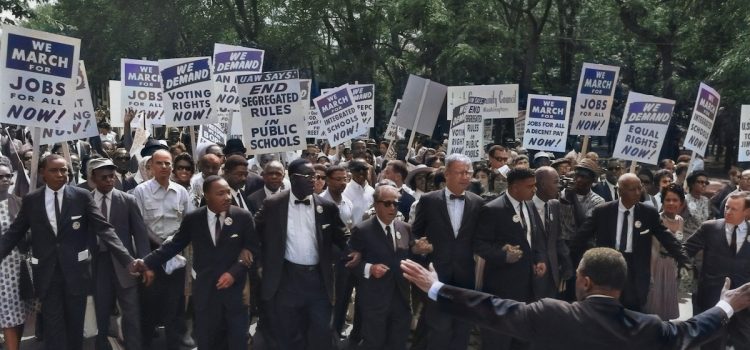

This article is an excerpt from the Shortform book guide to "His Very Best" by Jonathan Alter. Shortform has the world's best summaries and analyses of books you should be reading.
Like this article? Sign up for a free trial here.
What was Jimmy Carter’s earliest relationship with the Black community like? How and why did his public position on segregation change over time?
Biographer Jonathan Alter discusses Jimmy Carter’s civil rights history and legacy in the book His Very Best. Alter describes a man who succumbed to the social and political pressure to keep quiet about his true beliefs—but only for a while.
Read on to learn about Jimmy Carter, civil rights, and this pivotal time in American history.
Jimmy Carter & Civil Rights
For Jimmy Carter, civil rights might have been a simple matter—except for the complications that he later allowed to be a factor. Carter was born in 1924 in the town of Plains, Georgia. He grew up working shoulder-to-shoulder with the African-American laborers his father employed on their farm. It was a time of strict racial segregation, yet, during the early years of his life, Carter’s family were the only white people he knew. When he started school, Carter’s white classmates mocked him for speaking with an African-American accent.
In the American South of the 1920s and ’30s, Jimmy’s mother Lillian was much more progressive on racial issues than her peers. As a nurse, she provided health care for the Carters’ Black neighbors, often without asking for anything in return. Carter would carry his mother’s legacy of concern for the health and well-being of the underprivileged into his political career and beyond.
Carter would find that maintaining his standing in southern, rural Georgia would clash with his views against racial discrimination. During the Civil Rights Movement, Carter chose to remain silent, a decision that served him politically but which he would later deeply regret. Alter describes how Carter’s Black neighbors influenced him as a child, though he downplayed that personal connection as his prominence grew in his community.
While Carter was born into an era of brutal racism and segregation, the farming area where he grew up outside of Plains was almost entirely African-American. As such, his childhood playmates and the families who helped raise him were mostly Black. They taught him many of his spiritual values, and it was the charismatic pastor of the local African Methodist Episcopal Church who served as one of Carter’s earliest role models.
(Shorftorm note: The African Methodist Episcopal (AME) Church is the oldest African-American denomination of protestant Christianity in the US, formed in Philadelphia in 1816 from an earlier organization known as the Free African Society. After the US Civil War, the AME Church spread throughout the South, and, by the end of the 19th century, it had reached Africa as well. Today, the AME Church has nearly three million members among 7,000 congregations worldwide. The one that figured prominently in Carter’s childhood was the St. Mark AME Church, founded in 1895, though its original site was destroyed in a fire in 1948.)
When the US Supreme Court ruled against school segregation in 1954, Carter feared the violent reprisals his African-American neighbors might suffer, but he and Rosalynn didn’t speak out on the subject despite favoring integration. Shortly after, Carter was appointed to the Sumter County Board of Education, where he made it his goal to make sure that public schools didn’t close down entirely, which was the response to school integration that many white Southerners favored. Carter rejected invitations to join the local White Citizens Council, and even that small display of racial tolerance earned Carter the ire of his white neighbors.
(Shortform note: Carter’s fears about his community’s reaction to the Supreme Court’s decision weren’t misplaced. In 1956, 101 US congressmen from the South, led by Representative Howard Smith of Virginia, signed a document now known as the Southern Manifesto, which urged their constituents to use any means necessary to keep their system of school segregation in place. In 1959, Virginia’s Prince Edward County shut down all its public schools to avoid integration and kept them closed for five years. In other places, attempts at school integration were met with violent protests for decades. Segregation didn’t officially end in the US until the integration of Mississippi’s Cleveland High School in the fall of 2017.)
Carter the Politician
Carter won a seat in the Georgia State Senate during the 1962 elections. But, to do so, he had to keep silent on his views about racial equality.
In 1970, Carter made a second bid for governor of Georgia. He avoided issues of race in his campaign by framing the discussion as one about class, education, and government spending. For two years before the election, Carter drummed up support door-to-door, reaching out to segregationists and the Black community at the same time. Alter claims that, while Carter never took an overtly racist stance, he used “dog whistles” to hint to racist voters that he was on their side, inadvertently pioneering a strategy that other politicians would hone to perfection over the following decades.
Alter explains that Carter played both sides of Georgia’s racial divide to secure his election, and then he pivoted on his first day in office to take a strong integrationist stance. During his 1971 inaugural address, he shocked his supporters and opponents alike by announcing that the segregation era must end.
Alter acknowledges the view of some liberals that Carter should have come out in support of civil rights much sooner than he did, but Alter makes the point that, if Carter had, his career would have died on the vine.
| The Southern Strategy Carter’s inaugural-day reveal of his racially inclusive vision for Georgia’s future was one step in a decades-long process that would transform the American South from a Democratic to a Republican Party stronghold. An analysis of polling data reveals that white Southerners’ views on racial policy were central to this shift, beginning with the push for civil rights legislation by Democratic presidents Kennedy and Johnson in the early ’60s. Starting in 1964, Republicans capitalized on this issue to woo the support of white Democratic voters in what is now known as the Southern Strategy. In 1968, Alabama Governor George Wallace, who came from the Democratic Party’s segregationist wing, employed a similar strategy that won back Southern votes but failed to win the presidency. Despite his loss, Wallace remained popular with Southern Democrats, meaning that Carter needed the votes of Wallace’s supporters for both his gubernatorial and presidential campaigns. |
Meanwhile, the fact that a Southern governor had spoken in favor of racial integration made national headlines and introduced Carter to the US at large. In office as governor, Carter immediately began appointing African-Americans to state office. He pushed his promised education platform, which now included integrating schools, and he was the first Georgia governor to commemorate civil rights leaders with portraits in the state capitol. Alter writes that despite Carter’s anti-segregation policies, he was still deeply tied to his identity as a Southerner. However, Carter believed the South had to grow beyond its racist past if it was ever to move forward into the future.
(Shortform note: As Carter did in the ’70s, many modern Southerners struggle with conflating regional pride with historical symbols of oppression. The push to remove Civil War monuments has been met with both resistance and support amidst the debate over how to best represent the American South’s troubled past. Negative stereotypes of the South persist, such as Southerners being viewed as ignorant and racist. Nevertheless, many Southern natives take pride in the things that sprang from their multicultural heritage, such as music, literature, cuisine, athletics, and an overall culture of hospitality—a sentiment that’s shared by white and black Southerners alike.)
| The Changing Democratic Party The US’s two major parties sprang from the same root—the Democratic-Republican Party founded by Thomas Jefferson and his allies. After defeating the Federalist Party in 1800, the Democratic-Republicans functioned as the US’s dominant political group until splitting in the presidential election of 1824. The bloc led by John Quincy Adams, which favored the interests of the northeastern states, became known as the National Republicans, whereas supporters of Andrew Jackson, whose power drew heavily from the South, became the Democratic Party. During the 1800s, the Democratic Party favored limited federal government, but the party fractured in 1860 over the issue of slavery, allowing Lincoln to win the presidency. After the US Civil War, the Democratic Party continued to stand against a strong central government and African-American rights. However, both these positions would change in the 20th century. The first shift happened when Democratic president Franklin D. Roosevelt expanded the federal government to create work programs and infrastructure projects to lift the country out of the Great Depression. The party remained split on race as northern Democrats like John F. Kennedy pushed civil rights reform while those in the South favored segregation. When Republican presidential candidate Barry Goldwater opposed the Civil Rights Act during his 1964 campaign, many African-Americans switched to the Democratic Party, which enabled Southern integrationists like Carter to finally act on their views. |

———End of Preview———
Like what you just read? Read the rest of the world's best book summary and analysis of Jonathan Alter's "His Very Best" at Shortform.
Here's what you'll find in our full His Very Best summary:
- A fresh perspective on Jimmy Carter's time as president
- How Carter's early life shaped his political career
- The long-term effects of what Carter accomplished while president






